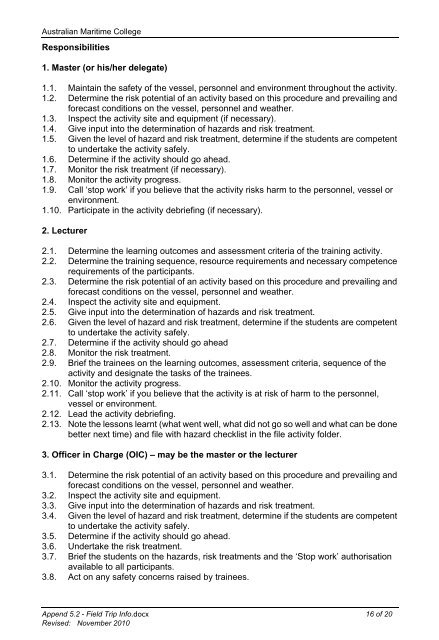MV BLUEFIN QUALITY MANUAL - Australian Maritime College
MV BLUEFIN QUALITY MANUAL - Australian Maritime College
MV BLUEFIN QUALITY MANUAL - Australian Maritime College
You also want an ePaper? Increase the reach of your titles
YUMPU automatically turns print PDFs into web optimized ePapers that Google loves.
<strong>Australian</strong> <strong>Maritime</strong> <strong>College</strong><br />
Responsibilities<br />
1. Master (or his/her delegate)<br />
1.1. Maintain the safety of the vessel, personnel and environment throughout the activity.<br />
1.2. Determine the risk potential of an activity based on this procedure and prevailing and<br />
forecast conditions on the vessel, personnel and weather.<br />
1.3. Inspect the activity site and equipment (if necessary).<br />
1.4. Give input into the determination of hazards and risk treatment.<br />
1.5. Given the level of hazard and risk treatment, determine if the students are competent<br />
to undertake the activity safely.<br />
1.6. Determine if the activity should go ahead.<br />
1.7. Monitor the risk treatment (if necessary).<br />
1.8. Monitor the activity progress.<br />
1.9. Call ‘stop work’ if you believe that the activity risks harm to the personnel, vessel or<br />
environment.<br />
1.10. Participate in the activity debriefing (if necessary).<br />
2. Lecturer<br />
2.1. Determine the learning outcomes and assessment criteria of the training activity.<br />
2.2. Determine the training sequence, resource requirements and necessary competence<br />
requirements of the participants.<br />
2.3. Determine the risk potential of an activity based on this procedure and prevailing and<br />
forecast conditions on the vessel, personnel and weather.<br />
2.4. Inspect the activity site and equipment.<br />
2.5. Give input into the determination of hazards and risk treatment.<br />
2.6. Given the level of hazard and risk treatment, determine if the students are competent<br />
to undertake the activity safely.<br />
2.7. Determine if the activity should go ahead<br />
2.8. Monitor the risk treatment.<br />
2.9. Brief the trainees on the learning outcomes, assessment criteria, sequence of the<br />
activity and designate the tasks of the trainees.<br />
2.10. Monitor the activity progress.<br />
2.11. Call ‘stop work’ if you believe that the activity is at risk of harm to the personnel,<br />
vessel or environment.<br />
2.12. Lead the activity debriefing.<br />
2.13. Note the lessons learnt (what went well, what did not go so well and what can be done<br />
better next time) and file with hazard checklist in the file activity folder.<br />
3. Officer in Charge (OIC) – may be the master or the lecturer<br />
3.1. Determine the risk potential of an activity based on this procedure and prevailing and<br />
forecast conditions on the vessel, personnel and weather.<br />
3.2. Inspect the activity site and equipment.<br />
3.3. Give input into the determination of hazards and risk treatment.<br />
3.4. Given the level of hazard and risk treatment, determine if the students are competent<br />
to undertake the activity safely.<br />
3.5. Determine if the activity should go ahead.<br />
3.6. Undertake the risk treatment.<br />
3.7. Brief the students on the hazards, risk treatments and the ‘Stop work’ authorisation<br />
available to all participants.<br />
3.8. Act on any safety concerns raised by trainees.<br />
Append 5.2 - Field Trip Info.docx 16 of 20<br />
Revised: November 2010


